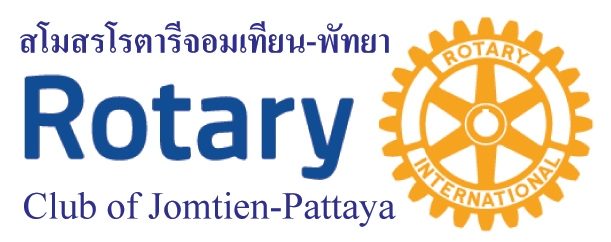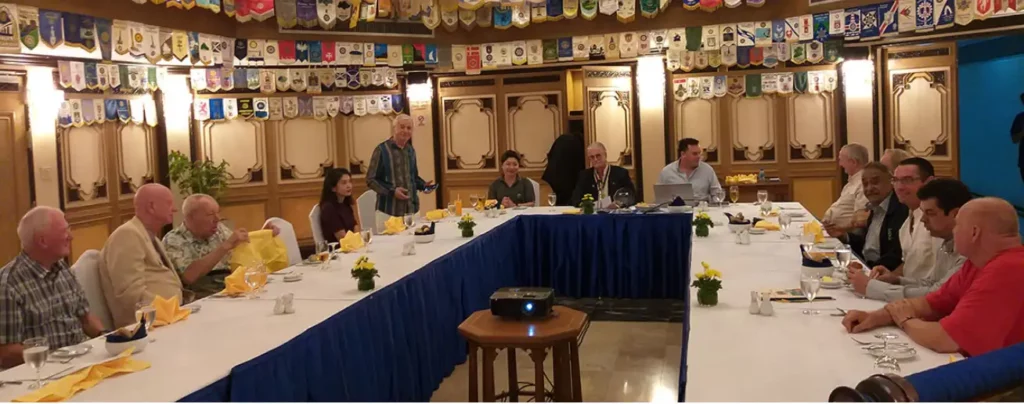HISTORY OF ROTARY IN THAILAND
AND THE ROTARY CLUB OF JOMTIEN-PATTAYA, FOUNDED IN FEBRUARY 1987
Rotary Clubs draw their membership from the local business and professional community in their area. Therefore, it is useful to know something about the history and development of Pattaya to appreciate how this has affected the existence of Rotary Clubs.
Pattaya itself is a place that has developed rapidly over a relatively short time-scale. In fact, at the time when Rotary began in Chicago in 1905, Pattaya, as we know it today, didn’t even exist. On the stretch of coast between Sri Racha and Sattahip, there were only a few small fishing villages; and in Pattaya Bay itself there were just a few fishing families who had settled here because of the calm waters and the safety of the bay, protected by headlands to the North and South and by mountains behind. Their nearest neighbours lived just around the headland to the north, where, in the old days, salt used to be produced (Naa Klua means salt fields) but where there were now mainly fishing families. People travelled about by foot or by bullock carts because, except for the main road from Bangkok to Sattahip, only a few dirt roads and tracks existed. Nevertheless, the bay and nearby islands provided good, safe fishing so more and more families came here to settle down. Gradually a village developed and at first it was known as Tapphraya, the general name for the area, this dated back to the time when Phraya Taksin (Duke Taksin) camped near here with the followers he had gathered to help free Thailand from the Burmese. As the village grew, the villagers wanted to give it separate identity, so about 70 years ago they adopted the name of Phatthya, which was the name they used for the strong winds which came from the South West at the start of every rainy season. Today the name is usually spelled Pattaya.

The pace of life was slow and it seemed as if Pattaya would remain an out of the way place forever. Even up to 50 years ago there were only a few buses serving the 100 or more families who lived here; visitors from elsewhere were few and far between.
However, things were destined to change and, as usual, it was a war that changed them. USA sent soldiers to build the airbase at U-Tapao and many of these took to spending their leisure time and money in Pattaya; the beaches were clean in those days, and the sea breeze made it pleasant and cool. People in the areas around were quick to spot the business opportunities, and soon bars and guesthouses began to spring up. The fisher-folk probably resented this intrusion, but it provided a good market for their catch so they soon got on the bandwagon by offering fishing trips to Kho Laan for 50 or so baht per head. Gradually, visitors from Bangkok also began to use the resort at weekend times, although the trip was a tiring 3 to 4 hours on the two-lane road.
Later on, the US military based in Thailand began to use Pattaya for “rest and relaxation” (R&R), and bigger hotels and entertainment places (including the oldest profession of them all) were built to cater for them. Thus the ’60s and ’70s saw the most rapid change and development. In 1964, due to its new importance, Pattaya was raised from the status of a village. In 1976 Pattaya and Naklua joined forced to become one administrative district. With the Pattaya City Act in 1978 a combined Pattaya and Naklua formed a government municipality. Thus was Pattaya City born.
In 2004 about 5 million visitors arrived to Pattaya.
Rotary had arrived in Thailand long before all this, but it wasn’t until the ’70s that Pattaya had grown large enough and had a sufficient variety of businessmen and professions to support its own Rotary club. In 1985 the King of Thailand became the patron of Rotary in Thailand.
The R.C. Pattaya was founded 19 November 1972 and. had both Thai and ‘Farang’ (foreign) members. However, the number of ‘Farangs’ involved in businesses and the tourist industry continued to increase. Many of these came from Rotary backgrounds in their own countries and the club gradually evolved into one with a large proportion of these. Amongst them were many transient members whose jobs would mean their moving on elsewhere in a couple of years and, who were not interested in becoming fluent in the Thai language. Over a period of time, these language problems led to the decision to form a separate ‘English speaking’ club.
This new club, the Rotary Club of Jomtien-Pattaya, received its Charter in February 1987.
In 2001 a new English-speaking club, R.C. Taksin-Pattaya, was founded and sponsored by our club. Two more clubs have later been founded, R.C. Eastern Seaboard in 2003 and the French-speaking R.C. Pattaya Marina in 2004.
| District Governor 3340 | |
| Premprecha Dibbayawan | 2000-2001 |
| Pratheep Malhotra | 2008-2009 |
| The Presidents | |
| 1. CP Hans Zurfluh 2. Premprecha Dibbayawan 3. Niels Colov 4. Nicolas Demet 5. Andre Comeau 6. Pratheep Malhotra 7. Ratana Yothawong 8. Michael Vogt 9. Dennis Stark 10. Kees Peperkamp 11. Premprecha Dibhayawan 12. John Richards 13. Bancha Mungchana 14. Erika Keller 15. Alvi Sinthuvanik 16. Bruno C. Keller 17. David Jeater 18. Pratheep Malhotra 19. Judy Hoppe 20. Chris Gibbins 21. Max Rommel 22. Jan Abbink 23. Brendan Thomas Kelly 24. Helmut Buchberger 25. Gudmund Eiksund 26.Dieter Reigber 27. Graham Hunt Crowley 28. Vutikorn Kamolchote 29. Max Rommel 30. Dzenana Popin 31. Nachlada Nammontree 32. Vutikorn Kamolchote 33. Joachim Klemm 34. Peter Marsh 35. Ray Whitley | 1987-1988 1988-1989 1989-1990 1990-1991 1991-1992 1992-1993 1993-1994 1994-1995 1995-1996 1996-1997 1997-1998 1998-1999 1999-2000 2000-2001 2001-2002 2002-2003 2003-2003 1 Jul. – 4 Nov. 2003-2004 5 Nov. – 30 Jun. 2004-2005 2005-2006 2006-2007 2007-2008 2008-2009 2009-2010 2011-2012 2012-2013 2013-2014 2014-2015 2015-2016 2016-2017 2017-2018 2018-2019 2019-2020 2020-2021 2021-2022 |



